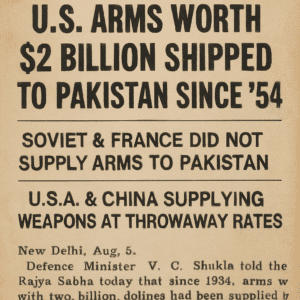Beyond Headlines: India’s 1971 Archive Post Sends a Sharp Geopolitical Message
The Indian Army’s Eastern Command invoked a potent historical parallel to counter recent U.S. pressure, sharing a 1971 newspaper clipping detailing substantial U.S. arms shipments to Pakistan during the lead-up to the Bangladesh Liberation War. This deliberate archival post came just one day after former U.S. President Donald Trump threatened India with severe tariffs over its Russian oil imports while simultaneously reducing tariffs for Pakistan.
The 54-year-old clipping, quoting then-Defence Minister V.C. Shukla, explicitly contrasted Soviet and French arms denials to Pakistan with active U.S. and Chinese military support. By highlighting this historical U.S. backing of India’s primary regional adversary during a critical conflict, the Army subtly but powerfully challenged the moral framing of Trump’s tariff threat and exposed perceived Western hypocrisy. India officially condemned the U.S. approach as “inconsistent and selective,” noting its Russian oil purchases were initially encouraged by the West as a market necessity post-Ukraine invasion.
The Army’s action transcended a mere historical reminder; it signalled India’s enduring memory of strategic partnerships perceived as adversarial and asserted its sovereign right to make energy decisions based on national interest, free from selective lecturing. This sophisticated use of archival diplomacy underscored that nations navigate present pressures through the lens of past experiences, firmly rejecting external coercion when framed against inconsistent historical actions. Ultimately, it reinforced India’s commitment to strategic autonomy grounded in historical context and national security imperatives.

Beyond Headlines: India’s 1971 Archive Post Sends a Sharp Geopolitical Message
The Indian Army’s Eastern Command recently made waves not with a new weapons display, but with a carefully curated piece of history. On August 5th, 2025, they shared a faded newspaper clipping from exactly 54 years prior – August 5th, 1971. The timing was unmistakably deliberate, arriving just one day after former US President Donald Trump threatened “substantially” higher tariffs on Indian goods, citing India’s continued import of Russian oil.
The 1971 Echo: The shared clipping reported then-Defence Minister V.C. Shukla’s statement in the Rajya Sabha (India’s upper house of parliament). It highlighted a stark contrast in international support during the tense build-up to the 1971 India-Pakistan war, which led to Bangladesh’s liberation:
- Soviet Union & France: Explicitly denied supplying arms to Pakistan.
- United States & China: Were actively supplying weapons to Pakistan, reportedly at “throwaway prices.”
- The Staggering Figure: The headline screamed “U.S. ARMS WORTH $2 BILLION SHIPPED TO PAKISTAN SINCE ’54” – a colossal sum adjusted for inflation, underscoring decades of military support to India’s primary regional adversary during a critical juncture.
The 2025 Trigger: Trump’s Tariff Threat Trump’s warning framed India’s purchase of Russian oil as profiteering amid the Ukraine conflict (“They don’t care how many people are dying in Ukraine”) and promised punitive tariffs. This contrasted sharply with his simultaneous move to reduce tariffs on Pakistan by 10%. India’s official response criticized the West’s “inconsistent and selective approach,” noting that its Russian oil imports began as a market necessity initially encouraged by Western nations seeking alternatives to Russian energy after the Ukraine invasion.
Why a 54-Year-Old Clipping? The Unspoken Message The Indian Army’s post, captioned “This Day That Year – Build Up of War,” wasn’t merely a history lesson. It was a masterclass in diplomatic signalling:
- Historical Context as Rebuttal: It implicitly countered Trump’s moralizing by reminding the US (and the world) of its own extensive history of supplying arms to a military regime engaged in conflict (Pakistan in 1971), arguably during a humanitarian crisis in East Pakistan (now Bangladesh).
- Highlighting Strategic Hypocrisy: The post underscored the perceived inconsistency in US foreign policy: criticizing India’s pragmatic energy trade with Russia today, while actively arming Pakistan against India in the past (and maintaining complex ties since).
- Asserting Sovereignty & Memory: It served as a powerful reminder that India has a long memory. Strategic decisions perceived as detrimental to Indian interests, even decades old, are not forgotten. It reinforced India’s stance that its current foreign policy choices, driven by national interest and energy security, are non-negotiable under external pressure.
- Symbolic Counterweight to Tariff Favoritism: The contrast between threatening India and reducing tariffs for Pakistan likely amplified the resonance of the historical parallel for the Indian audience and policymakers.
Beyond the Tweet: The Enduring Lesson This archival gesture transcends the immediate Trump tariff threat. It speaks to a core principle of India’s evolving foreign policy: strategic autonomy. India is signalling it will not be lectured on its international partnerships, especially by nations whose own historical records in the region are complex. The post deftly used history to:
- Challenge the moral high ground assumed in contemporary criticism.
- Assert that current relationships are viewed through the long lens of past interactions.
- Demonstrate that pressure tactics are unlikely to yield concessions when framed hypocritically.
The Indian Army‘s tweet was far more than nostalgia. It was a calibrated, historically grounded diplomatic statement. It reminded the US, and the world, that nations navigate the present with the lessons of the past firmly in mind. When calling out perceived inconsistencies in others’ actions, one’s own historical record may well become part of the conversation. India’s message is clear: its strategic choices are made with a deep understanding of history and an unwavering focus on its own national interest.
You must be logged in to post a comment.